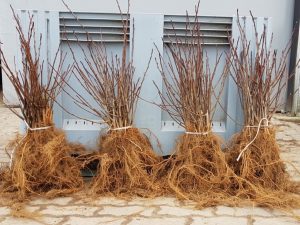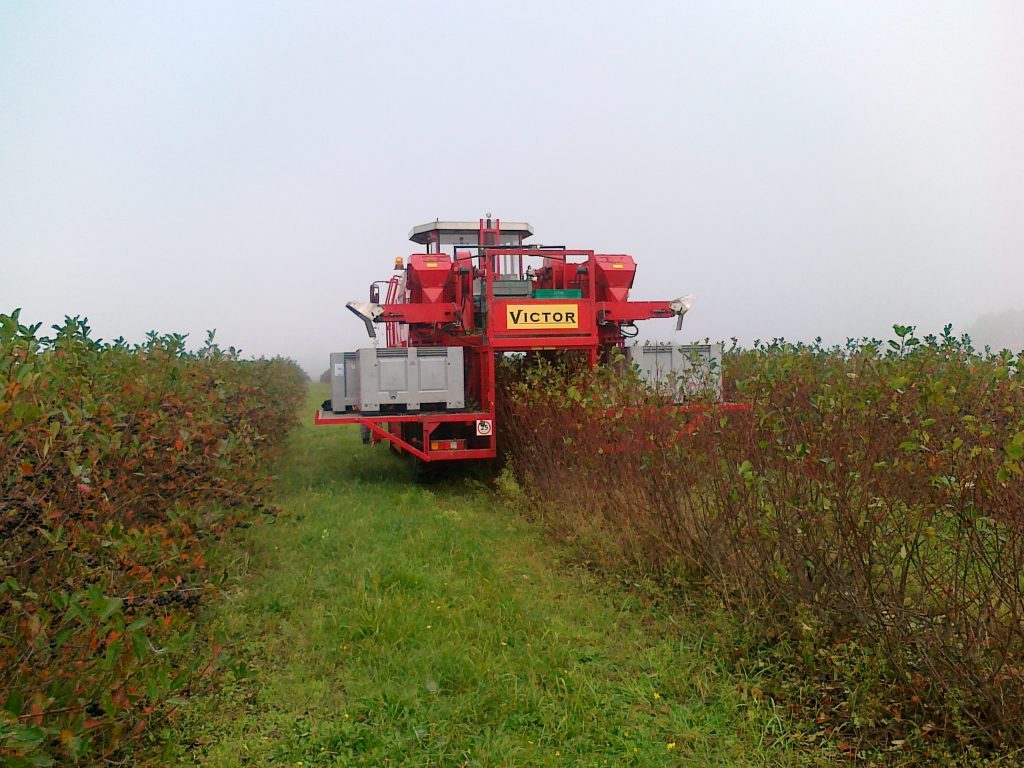Aronia (chokeberry) cultivation guide
Aronia is a low-demanding shrub. It adapts very well to practically every environmental and soil conditions. It can be cultivated practically everywhere except for mountain areas.
The strength of aronia shrubs and their ability to adapt to the prevailing conditions is confirmed by the presence of plantations of these plants in western Siberia, in the zone of forest-steps with an acute continental climate.
Aronia is very resistant to diseases and pests compared to other fruit plants. It owes its resistance to a large number of polyphenols, which effectively protect it against bacteria and fungi. Also most insects are reluctant to feed on chokeberry bushes due to the high content of flavonoids.
Soil and climatic requirements
Aronia can be grown on practically all types of soil. Like most fruit plants, it grows best on fertile soils rich in humus, but it can also be grown on worse soils.
Too good soil (I-II class) may even be a problem in some cases, because in such favourable conditions aronia tends to grow lushly, which may cause excessive growth of bushes hindering mechanical harvest of fruit. For this reason, chokeberries are usually planted on soils of classes III-V and sometimes even VI.
Aronia also have no particular climatic requirements. The most optimal conditions for growing chokeberry are in the temperate zone, but given its resistance to frost and high temperatures, it can be grown in most places on earth.
The demand for water does not differ from the needs of other fruit plants – rainfall in the range of 500-600mm per year is fully sufficient for its proper development. Water shortages affecting the yield can only occur during the July and August droughts, during dynamic fruit growth.
Plantation design
When designing a plantation, it should be adapted to the possibility of mechanical harvesting – even if we do not yet have a harvester. The optimum distance between rows is 4 – 4.5 metres. On weaker soils, if necessary (very narrow plot) the distance can be reduced to a maximum of 3.7 metres. A smaller distance will prevent the machines from entering field once the shrub has reached its full dimensions. For Class III and IV soils, a minimum distance of 4 metres must be maintained.
The plants in rows should be planted every 60 centimetres or so. Only dense planting allows for a proper mechanical harvest. Thanks to this spacing, the shrubs will quickly form a line allowing the harvester to work evenly. When the plants are planted too rarely, the harvester “jerks”, breaking branches and leaving a large amount of fruit on the bush. Plantations with denser planting in the first years also give proportionally higher yields, which in a short period of time compensates for the cost of purchasing more cuttings.
If possible, the rows should be drawn across the most common winds. This type of location will reduce the drying effect of the wind in summer and accumulate more snow in between rows in winter, thus increasing the water supply for the spring period.
At the ends of the plantation, a square about 8 meters long should be left unoccupied. This will allow the harvester to manoeuvre freely during the turning.
At the edges of the plantation a distance of about 2.5 meters should be kept. The aim is to allow the combine harvester and the lawnmower to pass through.
When designing a plantation with long rows, it is also necessary to remember to leave spaces every 400-500 meters for transverse roads enabling the change of crates on the harvester and easier bringing the machines in case of failure.
In case of fields with a steep slope (mountainous and foothill areas), shrubs should be planted along the slope. Harvesters have a high centre of gravity, which may even result in the machine tipping over if the side tilt is too steep.
What to pay attention to when choosing aronia plants?
The most important thing when setting up a plantation is, of course, choosing the right plants. When establishing aronia plantations, only vegetative plants (propagated by splitting the parent shrub) bought from a trusted nursery should be used. Vegetative cuttings faithfully transfer the characteristics of the parent plant, thus guaranteeing a regular high yield (if the purchased material was of good quality).
When buying generative seedlings, we buy shrubs with random traits. Shrubs produced from this type of plants give irregular yields, usually much worse than selected vegetative ones, and tend to overgrow, which makes mechanical harvest impossible after a few years.
Generative seedlings from seeds are much cheaper than vegetative plants because of the much easier way of production. However, it should be remembered that the quality of the plants determines the yield for the next 20 years. By buying plants at a bargain price from an unproven source or seedlings from seeds we risk potential losses throughout the entire fruiting period.
An important issue when choosing aronia plants is also their variety. The most recommended variety is NERO, which is characterized by high elasticity of shoots and moderate height allowing for trouble-free mechanical harvesting, as well as repeated annual fruiting.
For setting up a plantation we recommend buying two or three year old plants. They are more expensive than one-year-old ones, however, their higher cost pays off very quickly – they bear fruit at least one year earlier and are not so easily jammed by weeds, so they grow much faster in the first year.
When choosing aronia plants you should pay special attention to their root system. It should be well-developed, with a large number of hairs and without any nodular changes. When buying plants, you should not be guided solely by their height, but rather by the number of shoots and the ratio of root size to cuttings themselves.
Plants should not have green leaves. Their presence means that the cuttings were dug up too early before the end of vegetation and that the shoots are not fully ligneous.
Preparation of the field for plantation
Proper preparation of the soil before planting allows the aronia to develop properly and saves labour in the first years. Above all, the soil should be cleaned of weeds. This is particularly important when planting the plantation with one- and two-year-old plants, as chokeberries up to the age of four are prone to weeds.
It is a good idea to use a forecrop during the vegetation period before the establishment of a plantation for the early ploughing of e.g. lupine or vetch.
The optimal pH for aronia growth is 6.5, so it is advisable to check the pH of the soil one year before planting the plantation and, if necessary, carry out liming. On light soils it is best to use magnesium-carbonate lime and on heavy soils magnesium-oxide lime.
The growth of plants on weaker soils is very well affected by manure fertilization. It should be applied about 2 weeks before the establishment of a plantation, then everything should be ploughed and harrowed.
When to plant aronia?
When studying chokeberry, it was observed that the root system is still active in late autumn and early winter, until the ground is not frozen. For this reason, the best time to establish a plantation is autumn. A more developed root system ensures faster growth of plants in spring. However, nothing stands in the way of setting up plantations in spring.
For planting aronia, it is recommended to use a gently modified tractor orchard planter – the planter should be 30 cm longer and 5-7 cm deeper, so that the plants can be freely planted to a depth of 35 cm. Deeper placement of the cuttings in the ground leads to an increase in the root system area, which allows the plant to absorb more nutrients. This is particularly important in the case of plantations established on weaker soils.
Aronia bushes should be planted every 50-70 cm depending on the soil class. This means that to set up 1ha of plantation you need to buy 4000-5000 plants. Shrubs planted too rarely may not form a line, which may make mechanical harvesting impossible or difficult (“jerking” of a harvester, breaking branches and inaccurate fruit harvesting).
After planting, the soil should be leveled with a toothed harrow.
Fertilisation and spraying
It is very important to support aronia in the first two years after planting. This will ensure a much faster growth of the shrubs and thus a quicker return on costs.
Weed infestation is a very serious problem in the first two years. Aronia bushes do not yet have a sufficiently developed root system to cope with them. In the first year the plantation should be weeded about once a month. It is also possible to use herbicides, but the dose should be carefully selected so that the substances do not get into the root system of the plant.
Once the young shoots have reached a height of about 15 cm, you can start applying nitrogen fertilisers. The dose per 1ha is about 100kg (for Salmag). It can be applied during the vegetation every 3-4 weeks.
In the second year the procedures are very similar. From the third year, aronia shrubs should be able to stun the weeds themselves without any problem. Also nitrogen fertilization becomes unnecessary, and in the case of plantations established on high-grade soils even harmful – it can lead to too much growth of shrubs, which will make mechanical harvesting difficult in the future.
Aronia trimming
The first cut should be made immediately after the plantation is planted. Aronia pruning is necessary for one-year-old and two-year-old cuttings (provided they are more than 40 cm high after planting). Its purpose is to balance the size of the roots, which are reduced when digging the cuttings, to the aboveground part. This is particularly important in dry springs, where the root system may not be efficient enough to supply the plant with enough water.
The cuttings should be cut to a height of about 10 cm.
For multi-stemmed two-year-old plants with a strong root system and an overground height of less than 40 cm, there is no need for pruning.
The same applies to three-year-old plants, which have the additional advantage of bearing fruit the year earlier.
Harvesting aronia
Aronia harvest usually takes place in the second half of August. The exact date of harvest depends on the weather conditions of the year and may vary by two weeks.
The fruit is ripe when its peduncle changes colour from green to light red. Do not start harvesting, especially mechanically, until this is done. The green peduncles are more difficult to break away from the bush, forcing the harvester to increase the strength of the shakers, which leads to damage to the bushes and shaking off too many leaves.
A very important feature of aronia fruits is their durability. Even keeping chokeberries in crates for several days after harvesting does not spoil them. This makes it possible to harvest the fruit from large areas and deliver the whole batch to the processing plant at once.
















